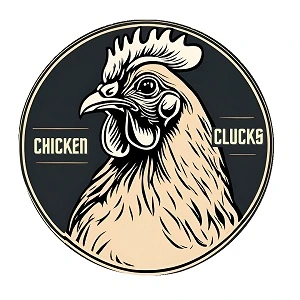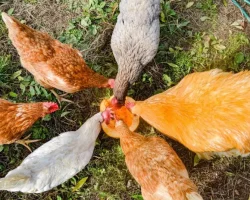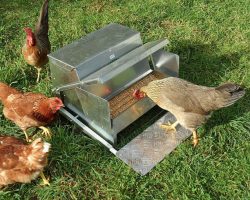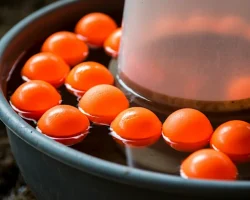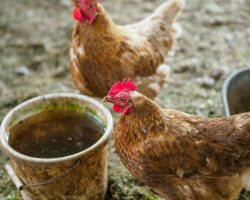Chicken grit is essential for chickens, aiding in food digestion and nutrient absorption since they lack teeth. Grit is used as a supplement next to chicken feed. This guide covers the types of grit, its role in a chicken’s diet, and tips for using it effectively. Discover why chicken grit is key to keeping your flock healthy and thriving.
Tip: Also read how to choose the best chicken feed for healthy hens.
What is chicken grit?
Chicken grit is essentially tiny stones that chickens eat to help them digest their food. There are two main types you’ll come across:
Insoluble Grit: Consists of stone such as gravel, flint or granite. Chickens do not digest insoluble grit, it stays in the gizzard to help grind feed mechanically.
Soluble Grit: Such as oyster shell grit, egg shell grit or limestone grit, is digested and absorped in the chicken’s digestive system and provides essential calcium. It’s like a two-for-one deal: grit that helps with digestion and strengthens bones and eggshells. If only all our supplements were this efficient!
Be aware that regular commercial chicken feeds already contain sufficient soluble (calcium) grit. So, you don’t need to supply it separately. However, especially for older layers, it can help to give a little extra soluble grit. Your hens will eat what they need.
Why do chickens need grit?
The reasons depend on the type of chicken grit. Yes, the 2 types of grit are very different!
Insoluble chicken grit
Chickens don’t have teeth. Instead, they rely on their gizzard, a specialized stomach that grinds their food with the help of grit. Grinding food into smaller particles is an essential part of the digestion process, since it increases the surface area for digestive enzymes to work on. Without it, chickens would be left with a whole lot of undigested feed and a sad cluck.
Soluble chicken grit
Laying hens need soluble grit to ensure they get enough calcium for strong bones and eggshells. If your chickens eat enough complete feed, they typically don’t need extra soluble grit. Complete feed already contains sufficient calcium. However, if you add kitchen scraps or other foods, supplementing with soluble grit is wise. Also, older hens require more calcium, as their absorption decreases with age, putting them at risk of osteoporosis and weak eggshells. Therefore, supplementing soluble grit or using special layer feed is beneficial for older layers.
Complete feeds usually contain fine limestone for pullets and limestone grit for layers. Fine and coarse limestone have roughly the same calcium content but their absorption speed differs. Because limestone grit is coarse, it digests and absorbs more slowly. This keeps blood calcium levels steady throughout the day, especially at night when the eggshell forms. Without enough calcium, hens will take it from their bones. On the long term this can lead to deformities or even breakage of the sternum, rib cage, beak and legs. Also, egg shells will become weaker and you will see more broken eggs and cracks in the shell.
Mixed grit and why not to use it
Mixed grit is available on the market, which contains both insoluble and soluble grit. Even though it is convenient to use mixed grit, I do not prefer it. Soluble and insoluble grit serve very different purposes, so I prefer to feed them separately. Also, when feeding mixed grit, you might not even notice if your chickens consume only the soluble portion, leaving behind the insoluble grit. This can lead to a lack of calcium and broken egg shells.
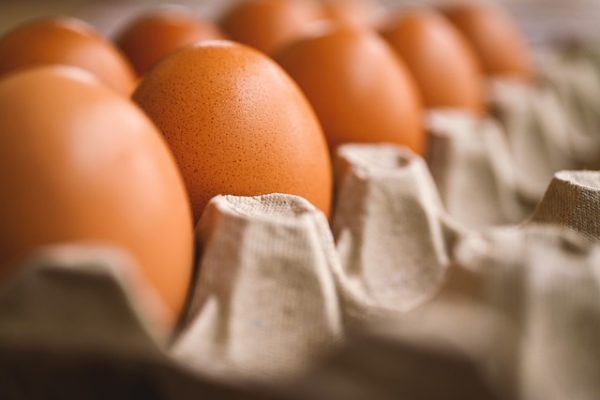
The great grit debate: natural vs store-bought
In nature, when chickens peck at the ground, they’re not just looking for food; they’re often picking up bits of grit. Some purists argue that natural grit—what chickens find on their own—is superior to store-bought grit. And while there’s a certain charm to letting chickens be chickens, there are benefits to store-bought grit. It is usually more consistent in size, which is gentler on your chickens’ gizzards. Also, it is cleaner and has no or less bacteria than natural grit. That’s why it is still a good idea to provide store-bought grit to your chickens, even if they can roam free on a piece of land.
DIY chicken grit from egg shells
Egg shells are rich in calcium and can be used as an alternative to limestone or oyster shell grit. First, crush the eggs shells until they are unrecognizable to prevent teaching your hens to eat their own eggs. A behavior that’s hard to unlearn once it starts. Then, bake the crushed shells in the oven for 10 minutes on 430 °F (220 °C) to kill any harmful bacteria. Make sure the shells are dry before storage. Never feed your flock egg shells from another flock! The oven doesn’t kill all micro-organisms and you could introduce unfamiliar diseases to your chickens.
when to start giving chicken grit?
Grit needs to be the right size for your bird. If it’s too small, it will just pass through without helping at all. On the other hand, if the grit is too big, it will not be eaten or can cause blockages or discomfort. Make sure you’re getting the correct size for your chickens.
Insoluble chicken grit
Stone grit comes in different sizes for chicks, pullets (young hens, not laying yet) and laying hens. Start giving insoluble grit to your chickens when they’re about 8 weeks old. You can start earlier with chick grit, but usually not before 3 weeks old. Always follow the advice on the bag or from the store.
Soluble chicken grit
Regular pullet and layer feeds have enough calcium, so extra soluble grit usually isn’t necessary. But if you’re also giving kitchen scraps or other foods, it’s best to add some supplemental soluble grit. You can start giving limestone or oyster shell grit when hens begin laying, typically around 17 to 18 weeks of age for most breeds. It’s also a good idea to provide extra soluble grit for older hens over 50 weeks old.
how much grit do chickens need?
The best approach is to provide both soluble as insoluble grit free of choice. Your chickens will take what they need and leave the rest. It’s difficult to give a precise amount since it depends on the chickens’ age and size, but a good rule of thumb is about 1 pound (0,45 kg) of grit every few months for mature hens. Just keep an eye on their supply and top it up when needed. For pasture raised chickens, not fed complete feed, more grit is needed. Interesting fact: complete layer feeds typically contain 6-9% of limestone grit, depending on the calcium level in the grit and other raw materials. Layer feeds for older layers contain higher levels.
How to provide grit to your chickens?
Now that you’re a grit expert, let’s talk about the best way to provide it to your chickens; separate chicken grit feeders. Having separate grit feeders offers several benefits:
- Your chickens can eat the exact amount of both types of grit they need.
- Keeps the grit clean and in some grit feeders also dry.
- Multiple hens can eat at the same time preventing competition.
- Prevents waste by chickens scratching out grit from the regular feed.
Therefore, don’t mix grit with the regular feed. Providing both soluble as insoluble grit free of choice in separate chicken grit feeders is ideal.
Final thoughts
Providing grit might seem like a small detail in the grand scheme of chicken keeping, but it’s one of those little things that make a big difference. Incorporating grit into your chicken-keeping routine pays off with healthier, happier hens with better digestion and stronger eggshells. It’s a win-win situation.
The next time you’re in your backyard, watching your chickens peck and scratch with contentment, you can feel confident knowing you’ve got the gritty details covered. And remember, a well-gritted chicken is a happy chicken.
